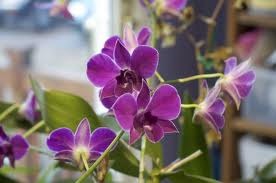Orchids have a reputation for being delicate, fussy plants that are difficult to grow in the home. The main obstacle the home grower faces is that orchids have extremely specific needs and quickly demonstrate stress when you do not meet their needs. The benefit is that when you identify and correct the problem, orchids will also quickly recover. An orchid’s leaves should grow green and have a slight leathery texture. Yellowing of the leaves is a definite sign of health problems that you must address before it endangers the life of the orchid.
Light
-
Too much light bleaches an orchid’s leaves, causing a yellowing of the leaves. The leaves of an orchid receiving too much light are often streaked with pale-yellow patches. Move the orchid away from the light source, or move it to an east-facing window to reduce its exposure to direct sunlight. Always protect an orchid on a window sill with blinds or sheer curtains, providing indirect light instead of harsh, direct light.
Nutrient Deficiency
-
Magnesium and iron deficiencies can cause an orchid’s leaves to develop a yellow tint. These nutrient deficiencies often turn the outer edges of the leaves yellow, leaving the grain in the leaf green. Special orchid potting mixes contain the necessary nutrients an orchid demands, so indoor orchids do not often suffer from deficiencies. However, the potting mix deteriorates over time. If the orchid is several years old, replant the orchid in fresh potting mix to provide it with the nutrients it needs.
Mites
-
Several varieties of mites enjoy feasting on the leaves and stems of orchids, the most common of which are spider mites and flat mites. Mites feed on the orchid at the cellular level, sucking the chlorophyll from the cells. The chlorophyll within a plant’s cells causes the plant to turn green, so the mite’s removal of chlorophyll causes the plant to yellow. Severe mite infestations can kill any house plant because chlorophyll, green leaves, are necessary for the plant to produce energy to perform basic cellular functions that sustain life. Treat mite infestations with a miticide, or spray or rub the infected areas with rubbing alcohol.
Lace Bugs
-
Lace bugs are more often a problem for outdoor orchids, but indoor orchids can experience infestations. Like mites, lace bugs feed on chlorophyll, which causes the leaves to yellow. Lace bugs cause the entire leaf to yellow from the top to the bottom, and they leave black, tar-like excrement on the leaves. To destroy lace bugs infecting an orchid, spray an insecticide specifically labelled as appropriate for lace bugs.


Deprecated: strpos(): Passing null to parameter #1 ($haystack) of type string is deprecated in /home/agriviek8Qv/agriviet.net/public_html/wp-includes/comment-template.php on line 2522